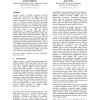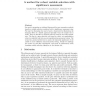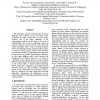APBC
2004
14 years 26 days ago
2004
Boolean models of genetic regulatory networks (GRNs) have been shown to exhibit many of the characteristic dynamics of real GRNs, with gene expression patterns settling to point a...
SDM
2007
SIAM
14 years 26 days ago
2007
SIAM
Individuals show different cell classes when they are in the different stages of a disease, have different disease subtypes, or have different response to a treatment or envir...
SDM
2008
SIAM
14 years 26 days ago
2008
SIAM
Gene expression information from microarray experiments is a primary form of data for biological analysis and can offer insights into disease processes and cellular behaviour. Suc...
NIPS
2008
14 years 26 days ago
2008
We address the challenge of assessing conservation of gene expression in complex, non-homogeneous datasets. Recent studies have demonstrated the success of probabilistic models in...
ESANN
2008
14 years 27 days ago
2008
Our goal is proposing an unbiased framework for gene expression analysis based on variable selection combined with a significance assessment step. We start by discussing the need ...
BMEI
2008
IEEE
14 years 1 months ago
2008
IEEE
The importance of gene expression data in cancer diagnosis and treatment by now has been widely recognized by cancer researchers in recent years. However, one of the major challen...
RECOMB
2000
Springer
14 years 3 months ago
2000
Springer
Constantly improving gene expression profiling technologies are expected to provide understanding and insight into cancer related cellular processes. Gene expression data is also
BIBE
2001
IEEE
14 years 3 months ago
2001
IEEE
DNA arrays can be used to measure the expression levels of thousands of genes simultaneously. Currently most research focuses on the interpretation of the meaning of the data. How...
CIKM
2006
Springer
14 years 3 months ago
2006
Springer
Microarray technology is a powerful tool for geneticists to monitor interactions among tens of thousands of genes simultaneously. There has been extensive research on coherent sub...
CSB
2004
IEEE
14 years 3 months ago
2004
IEEE
The advent of DNA microarray technologies has revolutionized the experimental study of gene expression. Clustering is the most popular approach of analyzing gene expression data a...




